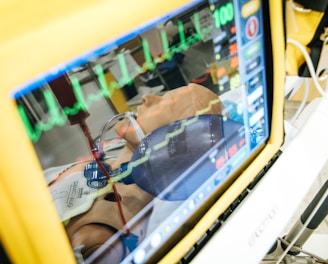Use Cases
Radiograph and Medical Imaging Analysis with AI
Enhancing diagnostic accuracy and efficiency through AI-powered medical imaging analysis.
AI-driven medical imaging analysis solution focuses on automating and improving the interpretation of radiographs, CT scans, MRIs, and other medical imaging data. Our embedded software integrates deep learning models trained to identify abnormalities, such as fractures, tumors, or lesions, with a high degree of accuracy. These AI models, embedded into existing imaging devices and healthcare platforms, work in real-time to assist radiologists and clinicians by providing automated annotations, flagging potential issues, and suggesting areas that require further examination.
Our software supports seamless integration with hospital Picture Archiving and Communication Systems (PACS) and Electronic Health Records (EHR), ensuring that the AI analysis can be reviewed alongside patient histories and other diagnostic information. With edge computing capabilities, the analysis can be conducted locally on the device, reducing latency and enabling rapid diagnosis, particularly in critical care environments.


Key Benefits:
AI-driven deep learning models for radiograph and imaging analysis
Real-time processing of CT scans, MRIs, X-rays, and more
Automated detection and annotation of abnormalities, such as fractures, tumors, and lesions
Seamless integration with PACS and EHR systems
Edge computing for on-device analysis and reduced diagnostic delays
Remote Patient Monitoring
Monitor patient health outside the hospital with real-time data and proactive alerts.
Remote Patient Monitoring (RPM) extends care beyond the clinical environment. Wearable technology and IoT-enabled devices track vital signs such as heart rate, blood pressure, and glucose levels, transmitting data for real-time analysis. Edge computing processes this information instantly, providing healthcare professionals with insights and alerts for any irregularities. This approach supports effective management of chronic conditions like diabetes and cardiovascular diseases, enhancing early intervention capabilities and reducing hospital visits.


Key Benefits:
Real-time health data tracking
Proactive alerts for timely interventions
Reduced hospital visits and improved patient outcomes
Personalized Medicine
Tailor treatments with AI-driven insights and wearable data
Personalized medicine leverages data from wearables and IoT devices, combined with AI algorithms, to provide customized treatment plans based on individual medical histories and real-time health metrics. The system analyzes genetic, lifestyle, and biometric data to generate insights that help healthcare providers optimize treatments, adjust medication, and identify health risks early. This approach maximizes treatment efficacy, enhancing patient satisfaction and outcomes by aligning healthcare delivery with patient-specific needs.


Key Benefits:
AI-driven data analysis for personalized treatment
Predictive healthcare to anticipate health risks
Enhanced patient engagement and adherence to treatment


Rehabilitation Support
Enhance recovery with wearable tech and real-time feedback.
Wearable technology supports patients in rehabilitation by tracking progress and providing real-time data. Devices monitor movements, muscle activity, and overall physical performance, with edge computing solutions processing this data instantly. This allows healthcare providers to follow progress, customize rehabilitation programs, and adjust exercises based on individual needs. Such an approach empowers patients to engage with their recovery process while maintaining a close connection with their healthcare provider.
Key Benefits:
Continuous monitoring of rehabilitation progress
Personalized therapy plans based on real-time data
Improved recovery times and reduced clinical visits
Smart Hospital Systems
Optimize hospital efficiency with AI and IoT-integrated systems
Smart hospital systems leverage AI and IoT technology to streamline hospital processes, from patient flow management and bed availability to equipment tracking and environmental controls. Embedded software and edge computing enable real-time monitoring and adjustment, ensuring that facilities operate efficiently while addressing emerging issues quickly. This enhances patient safety, optimizes resource use, and improves overall operational efficiency within healthcare facilities.


Key Benefits:
Automation of hospital operations for increased efficiency
Real-time monitoring of resources and patient flow
Enhanced patient safety and comfort


Predictive Healthcare Analytics
Turn data into insights for preventive care and risk management.
Predictive analytics processes large volumes of patient data collected through IoT devices, electronic health records (EHRs), and wearables. AI algorithms analyze this data to identify patterns and predict health risks, such as chronic illnesses or cardiovascular events. Real-time data analysis through edge computing provides healthcare providers with early warnings, enabling preventive measures and proactive patient management, ultimately improving patient health outcomes.
Key Benefits:
AI-driven insights for early risk detection
Real-time processing with edge computing
Improved preventive care and patient health outcomes
Emergency Response Systems
Enhance emergency care with real-time monitoring and quick alerts
Emergency response systems integrate AI and IoT technology to monitor critical health metrics in real-time. Wearable devices and IoT sensors in emergency rooms or ambulances track vital signs such as heart rate and oxygen levels. Data processing through edge computing ensures quick, precise analysis, facilitating timely medical decisions and interventions during critical situations. This supports faster response times and improved care during emergencies.


Key Benefits:
Real-time monitoring of critical health metrics
Automated alerts for faster medical response
Improved emergency care and patient outcomes


Sports Performance Monitoring with Wearable Tech
Optimize athletic performance with AI-powered sports monitoring.
Sports performance monitoring utilizes wearable technology to track key fitness metrics such as heart rate, oxygen saturation, calories burned, sleep patterns, and workout intensity. Edge computing processes this data instantly, providing users with feedback and personalized recommendations through a mobile app. AI algorithms analyze the data over time, enabling athletes to optimize training routines, avoid injuries, and enhance performance. This technology supports both professional athletes and fitness enthusiasts in achieving their fitness goals through precise monitoring and tailored insights.
Key Benefits:
Real-time monitoring of vital fitness metrics
AI-driven insights for personalized training recommendations
Injury prevention and performance optimization
Innovation
Transformative solutions for industries through advanced technology
Support
Contact
info@insparia.com
+44 131 618 9105
© 2024. All rights reserved.
+92 324 492 8771
